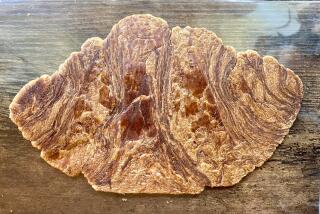Puff Piece
- Share via
Puff pastry--paper-thin sheets of dough separated by layers of butter--has been invented several times in several different places. One was medieval Spain; the oldest recipes for puff pastry appear in 13th century Spanish Arabic cookbooks. They say to roll dough out thin, smear it with butter, roll it up and then flatten it with your hands. They add that you can also fold the dough over on itself and flatten it again, which would make even more layers.
They called this dough muwarraqa, which means “leafy” in Arabic. It was used as the crust for a sort of cheese pie, but mainly it was baked, then crumbled up and mixed with stew. This might sound like a waste of effort to us--why make a stodgy stew when you could have a flaky pastry?--but the result was a particularly delicate version of the dish of meat and bread called tharid, which was known to have been the favorite dish of the prophet Muhammad.
The 13th century cookbooks also mention a couple of ways of making layered pastry that start out with separate sheets of thinly rolled dough. One of them was called foliatil, which meant “leafy” in medieval Spanish (the modern Spanish word for puff pastry, hojaldre, comes from it). It was just thin sheets of dough, buttered, stacked up and baked. It went strictly into tharid.
In a third method, a sheet of dough was fried on one side and flipped over, then a raw sheet was pressed onto the cooked side. The process was repeated to build up a multilayered loaf called a murakkaba. This is how they make the pastry for tharid in today’s Morocco (where thrid, as it’s now pronounced, is more like a pie than a stew), but in the Middle Ages cooks often slipped a date filling between the layers.
All this must explain the southern French pastry called pastel, which is virtually a strudel. Because we know for a fact that Austria never conquered Provence.


